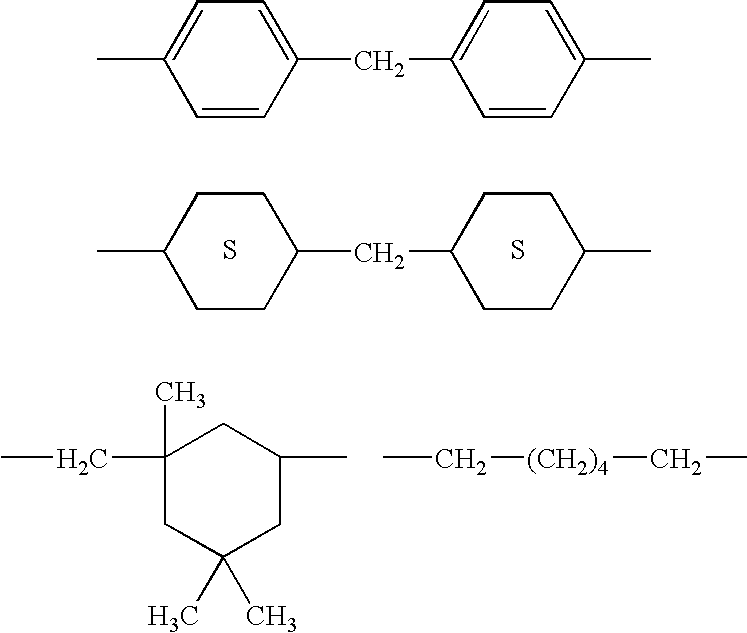Pigment based inks for high speed durable inkjet printing
a pigment-based inkjet printing, high-speed technology, applied in the direction of inks, non-fibrous pulp addition, paper-making, etc., can solve the problems of pigment-based inks, pigment-based inks often require a lengthy milling operation, and have a detrimental effect on optical density and gloss in printed images, and achieve the effect of low velocity variation
- Summary
- Abstract
- Description
- Claims
- Application Information
AI Technical Summary
Benefits of technology
Problems solved by technology
Method used
Image
Examples
example 1
Ink Example 1
[0108]A pigment blue 15:3 cyan pigment based inkjet ink formulation containing a polyurethane binder where 100% of the available acid groups in the polyurethane are neutralized with potassium hydroxide (PU-1).
[0109]Into an approximately 150 ml high density polyethylene bottle with magnetic stirring, the following components were added in order: 70.84 g of high purity water, 0.26 g of a 9.5 wt % solution of the biocide Kordek MLX, 5.63 g of ethylene glycol, 9.38 g of glycerol, 0.94 g of the nonionic surfactant Surfynol 465, 5.87 g of a 25.54 wt % solution of polyurethane PU-1, 4.55 g of a 25.0 wt % solution of acrylic polymer AC-1, and 27.58 g of a cyan pigment dispersion C-1 containing 9.98 wt % pigment PB15:3. The resulting 125 g of ink were stirred for at least an hour and filtered with a 1.0 um disk filter. The particle size distribution of pigment particles in this ink was such that the median particle size was 38.5 nm and 95% of the particles had a diameter less th...
example 2
Ink Example 2
[0110]A pigment blue 15:3 cyan pigment based inkjet ink formulation containing a polyurethane binder where 90% of the available acid gloups in the polyurethane are neutralized with potassium hydroxide (PU-2).
[0111]Into an approximately 150 ml high density polyethylene bottle with magnetic stirring, the following components were added in order: 71.99 g of high purity water, 0.26 g of a 9.5 wt % solution of the biocide Kordek MLX, 5.63 g of ethylene glycol, 9.38 g of glycerol, 0.94 g of the nonionic surfactant Surfynol 465, 4.72 g of a 31.76 wt % solution of polyurethane PU-2, 4.55 g of a 25.0 wt % solution of acrylic polymer AC-1, and 27.58 g of a cyan pigment dispersion C-1 containing 9.98 wt % pigment PB15:3. The resulting 125 g of ink were stirred for at least an hour and filtered with a 1.0 um disk filter. The particle size distribution of pigment particles in this ink was such that the median particle size was 45.9 nm and 95% of the particles had a diameter less tha...
example 3
Ink Example 3
[0112]A pigment blue 15:3 cyan pigment based inkjet ink formulation containing a polyurethane binder where 90% of the available acid groups in the polyurethane are neutralized with ammonium hydroxide (PU-3).
[0113]Into an approximately 150 ml high density polyethylene bottle with magnetic stirring, the following components were added in order: 70.80 g of high purity water, 0.26 g of a 9.5 wt % solution of the biocide Kordek MLX, 5.63 g of ethylene glycol, 9.38 g of glycerol, 0.94 g of the nonionic surfactant Surfynol 465, 5.92 g of a 25.34 wt % solution of polyurethane PU-3, 4.55 g of a 25.0 wt % solution of acrylic polymer AC-1, and 27.58 g of a cyan pigment dispersion C-1 containing 9.98 wt % pigment PB15:3. The resulting 125 g of ink were stirred for at least an hour and filtered with a 1.0 um disk filter.
PUM
| Property | Measurement | Unit |
|---|---|---|
| velocity | aaaaa | aaaaa |
| frequencies | aaaaa | aaaaa |
| jetting frequencies | aaaaa | aaaaa |
Abstract
Description
Claims
Application Information
 Login to View More
Login to View More - R&D
- Intellectual Property
- Life Sciences
- Materials
- Tech Scout
- Unparalleled Data Quality
- Higher Quality Content
- 60% Fewer Hallucinations
Browse by: Latest US Patents, China's latest patents, Technical Efficacy Thesaurus, Application Domain, Technology Topic, Popular Technical Reports.
© 2025 PatSnap. All rights reserved.Legal|Privacy policy|Modern Slavery Act Transparency Statement|Sitemap|About US| Contact US: help@patsnap.com


